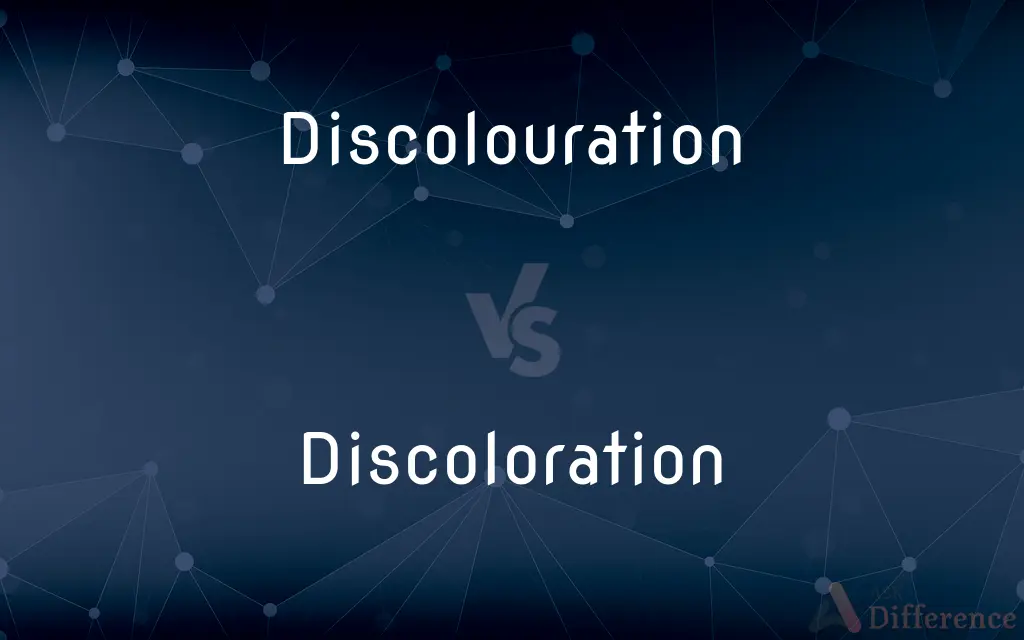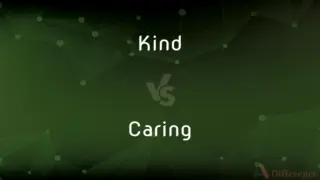Discolouration vs. Discoloration — What's the Difference?
Edited by Tayyaba Rehman — By Urooj Arif — Updated on April 7, 2024
Discolouration and discoloration refer to the process of changing color in an undesirable way, with the difference primarily in spelling: 'discolouration' is British, 'discoloration' is American.

Difference Between Discolouration and Discoloration
Table of Contents
ADVERTISEMENT
Key Differences
Discolouration (British English) and discoloration (American English) describe the process by which an object's color changes in an unwanted manner, often due to damage, aging, or exposure to certain substances. The key distinction between the two lies not in their meaning but in their spelling and regional usage. "Discolouration" follows the British English convention of adding a "u" to words like "colour," whereas "discoloration" adheres to the American English practice of spelling "color" without a "u."
In various contexts, such as medical, dental, and materials science, both terms are used to describe changes in color that indicate some form of deterioration or abnormal condition. For example, skin discoloration may suggest a medical issue, while discoloration of a material could indicate corrosion or fading. Despite the spelling differences, the implications and considerations in diagnosing or treating such changes remain consistent across English-speaking regions.
The choice between discolouration and discoloration is primarily determined by the intended audience or the regional standards of English being followed. In academic and professional writing, adherence to one spelling convention over the other is crucial for consistency and to avoid confusion. This distinction underscores the broader variations between British and American English, which extend beyond vocabulary to include spelling, grammar, and punctuation.
Understanding whether to use discolouration or discoloration is part of navigating the rich diversity of the English language. It highlights the importance of being aware of regional language conventions, especially in global communication, where the audience may include speakers of different varieties of English. This awareness ensures clarity and enhances the effectiveness of communication across different cultural and linguistic backgrounds.
Comparison Chart
Definition
The process by which something changes color in an undesirable way.
The process by which something changes color in an undesirable way.
ADVERTISEMENT
Spelling Region
Preferred in British English.
Preferred in American English.
Example Usage
"The document showed signs of discolouration due to age."
"The document showed signs of discoloration due to age."
Orthographic Preference
Includes a "u" following British spelling conventions.
Omits the "u" following American spelling conventions.
Contextual Application
Used in contexts like medicine, dentistry, and materials science across British English-speaking regions.
Used in similar contexts across American English-speaking regions.
Compare with Definitions
Discolouration
Change of color indicating potential damage or aging.
The ancient manuscript exhibited significant discolouration.
Discoloration
Change of color indicating potential damage or aging.
The ancient manuscript exhibited significant discoloration.
Discolouration
A symptom in medical diagnosis.
Discolouration of the skin can indicate underlying health issues.
Discoloration
A sign of material degradation.
The statue's bronze showed discoloration from corrosion.
Discolouration
A sign of material degradation.
The statue's bronze showed discolouration from corrosion.
Discoloration
A symptom in medical diagnosis.
Discoloration of the skin can indicate underlying health issues.
Discolouration
Undesirable fading of textiles.
The curtains have suffered discolouration from sunlight exposure.
Discoloration
Indicator of dental health issues.
Tooth discoloration may require professional whitening treatments.
Discolouration
Indicator of dental health issues.
Tooth discolouration may require professional whitening treatments.
Discoloration
Undesirable fading of textiles.
The curtains have suffered discoloration from sunlight exposure.
Discolouration
(British spelling) discoloration
Discoloration
The process of becoming discoloured, or the state of being discoloured
A bluish discoloration of the skin
Teeth with amalgam fillings may run the risk of discoloration
Discolouration
A soiled or discolored appearance;
The wine left a dark stain
Discoloration
The act of discoloring.
Discolouration
The act of changing the natural color of something by making it duller or dingier or unnatural or faded
Discoloration
The condition of being discolored.
Discoloration
A discolored spot, smudge, or area; a stain.
Discoloration
The act of discoloring, or the state of being discolored; alteration of hue or appearance.
Discoloration
A discolored spot; a stain.
Discoloration
The act of discoloring, or the state of being discolored; alteration of hue or appearance.
Discoloration
A discolored spot; a stain.
Discoloration
A soiled or discolored appearance;
The wine left a dark stain
Discoloration
The act of changing the natural color of something by making it duller or dingier or unnatural or faded
Common Curiosities
What does discolouration mean?
It refers to the change in color of an object or surface in an undesirable way, using British spelling conventions.
Why do discolouration and discoloration have different spellings?
The difference in spelling reflects the broader variations between British and American English, especially in the use of "ou" vs. "o" in certain words.
What does discoloration mean?
Identical to discolouration, it signifies an unwanted change in color, but follows American spelling rules.
Can discolouration be a sign of a serious condition?
Yes, in medical contexts, discolouration (or discoloration) of the skin, teeth, or eyes can indicate underlying health issues that may require attention.
Is one spelling more correct than the other?
Neither spelling is more correct; the choice depends on the regional spelling standards of the writer or the publication.
Are discolouration and discoloration interchangeable?
Yes, in terms of meaning, they are interchangeable; the choice depends on whether British or American English conventions are being followed.
Is discolouration a common issue in antiques?
Yes, discolouration is a common issue in antiques, often indicating age, exposure to elements, or previous restoration attempts.
How is discolouration treated in medical contexts?
Treatment varies widely based on the cause, ranging from topical medications to more invasive procedures.
Are there preventive treatments for skin discolouration?
Preventive measures include sunscreen use, avoiding harsh skin treatments, and maintaining a healthy lifestyle to minimize the risk of skin discolouration.
How do dentists treat tooth discolouration?
Treatments can include professional cleaning, whitening procedures, veneers, or crowns, depending on the severity and cause of the discolouration.
How can I prevent discolouration of materials?
Preventive measures may include protecting materials from excessive sunlight, chemicals, and moisture to reduce the risk of discolouration.
Do discolouration and discoloration only refer to negative changes?
Typically, these terms are used to describe undesirable or harmful color changes, though the context can vary.
Do both British and American English speakers understand both spellings?
Yes, speakers of both varieties of English will generally understand both spellings, despite having a preference for one based on regional conventions.
Can discolouration affect the value of art and collectibles?
Yes, discolouration can significantly affect the value and appeal of art and collectibles, often necessitating restoration.
Can professional cleaning remove discolouration from textiles?
Professional cleaning can often reduce or remove discolouration from textiles, though results can vary depending on the material and the cause of the discolouration.
Share Your Discovery

Previous Comparison
Kind vs. Caring
Next Comparison
Petite vs. PetitAuthor Spotlight
Written by
Urooj ArifUrooj is a skilled content writer at Ask Difference, known for her exceptional ability to simplify complex topics into engaging and informative content. With a passion for research and a flair for clear, concise writing, she consistently delivers articles that resonate with our diverse audience.
Edited by
Tayyaba RehmanTayyaba Rehman is a distinguished writer, currently serving as a primary contributor to askdifference.com. As a researcher in semantics and etymology, Tayyaba's passion for the complexity of languages and their distinctions has found a perfect home on the platform. Tayyaba delves into the intricacies of language, distinguishing between commonly confused words and phrases, thereby providing clarity for readers worldwide.
















































